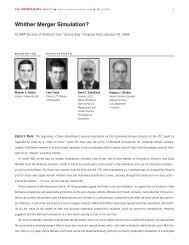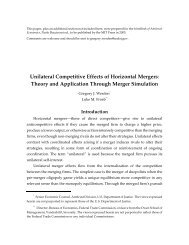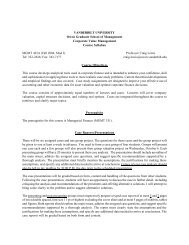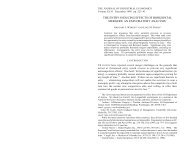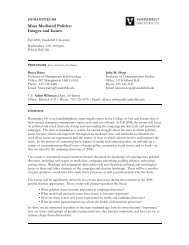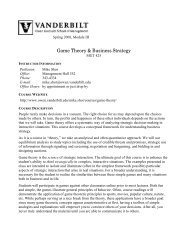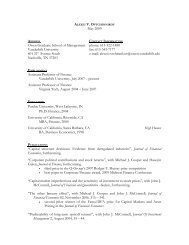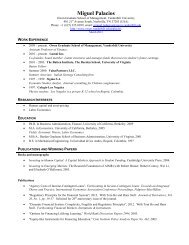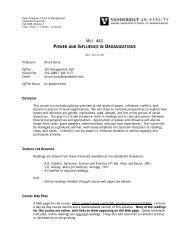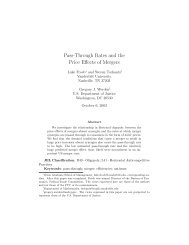Create successful ePaper yourself
Turn your PDF publications into a flip-book with our unique Google optimized e-Paper software.
Outline• I. merger enforcement statistics• II. If merger is answer, what is question?• III. Backlash against structural merger models• IV. Lessons from consummated mergers• V. FTC/DOJ Commentary on HorizontalMerger Guidelines• VI. Price-Concentration empirical mergermodels
1957 P&G-Clorox (Bleach)• Clorox dominant producer of bleach• P&G makes household items, but not bleach• FTC challenged merger because– P&G was most likely entrant into bleach– P&G was more efficient than other firms• …still waiting for P&G to enter
Baby Food Shares Since MergerUS Baby Food Market SharesFirmGerberHeinz (Del Monteafter 12-02)Beech-NutMarket Sharesmid 2000731113Market Shareslate 200380710
200420035000450040003500300025002000150010005000I. U.S. MERGER FILINGSI. U.S. MERGER FILINGS1981198219831984198519861987198819891990199119921993199419951996199719981999200020012002January 2001 SystemYearNumber of HSR Transactions
MERGER INVESTIGATION RATE5.00%2nd Requests as a Percentage of Total Filin4.50%4.00%3.50%3.00%2.50%2.00%1.50%1.00%0.50%0.00%1994 1995 1996 1997 1998 1999 2000 2001 2002 2003 2004Year
FTC Merger Challenges, 96-03908070Number of Markets60504030201002 to 1 3 to 2 4 to 3 5 to 4 6 to 5 7 to 6 8+ to 7+EnforcedSignificant CompetitorsClosed
US. vs. EC• US looks tougher than EC– US enforcement85% (2 nd requests)• 21 + 32 mergers– EC enforcement60% (Phase II)• Enforced + withdrawn (Mats Bergman)• But US investigates (2 nd requests) at lower rate– Actual enforcement may be much closer
Merger Challenge Predictor• Malcolm Coate & Shawn Ulrick (FTC),TRANSPARENCY AT THE FEDERALTRADE COMMISSION: THEHORIZONTAL MERGER REVIEWPROCESS 1996–2003– Antitrust Law Journal, 2005• Demo
II. If merger is the answer,What is the question?• Rule-of-thumb merger analysis– Are customers complaining?– Will merger lead to price increase?– Is there a benign reason for merger?• Most internal documents do a TERRIBLEjob of articulating merger motive– Brain-damaged, middle-management?
Do Mergers Move Assets toHigher-valued Uses?• Capitalism 101: Wealth is created whenassets move to higher valued uses– Voluntary transactions create wealth• Stock-market event studies estimate 75% ofmergers do NOT create value.– Target shareholders gain--but less thanacquiring firms lose– Experience reading internal merger documents• Why is it so hard to document valuecreation?
Uplifting Merger Story:Dell-Alienware• Companies were competitors, but…– Alienware makes liquid-cooled, high-end gamingcomputers– Dell makes full line of computers.• BIG and obvious synergy– Alienware keeps design, design, sales, marketing, andsupport of brand in separate Alienware Division– Dell manufactures Alienware machines
III. What’s s wrong with analysisbased on market shares?• 1. No bright line between “in” vs. “out” ofmarket• 2. Market Shares in market may be poorproxies for competitive positions of firms• 3. Other mechanisms at work: entry,efficiencies, re-positioning• 1+2+3 Market shares and concentration arepoor predictors of merger effects• Also, no way to do benefit-cost analysis
Merger Analysis RequiresPredictions about counterfactual• Two ways to do this.• Natural Experiments, e.g., in Staples-Office Depotcase, mergers analogous to differences betweenone- and two-superstore cities.– Did you hold everything else constant?– How well does experiment mimic merger effect?• Model-based prediction– Model current competition– Predict loss of competition following merger
Bertrand (price-only) Merger Model• Assumptions: Differentiated products, constant MC, Nashequilibrium in prices.• Model current competition– Estimate demand elasticity– Recover costs from FOC’s (P-MC)/P =1/|elasticity|• Prediction: Post-merger, MR for the merging firms falls assubstitute products steal share from each other– Merged firm responds by raising prices– Non-merging firms raise price sympathetically
Structural Model Backlash• How reliable are model predictions?• Test merger predictions against real mergers– Yes (Nevo, US breakfast cereal)– No (Peters, 3/5 US airlines; Weinberg, US motoroil and breakfast syrup)• Test model restrictions, i.e., does (pmc)/p=1/|elas|?– Yes (Werden, US bread; Slade, UK beer)
Backlash (cont.)• Does model leave out features that bias itspredictions?– Static, Price-only competition, MC constant• Research finds that ignoring…– demand curvature can under- or overstate merger effect– retail sector can under- or overstate merger effect– capacity constraints likely overstates merger effect– promotional competition likely understates mergereffect– repositioning likely overstates merger effect
Demand Curvature Matters• Following slide plots four demand curvesbetween competition and monopoly– Observationally equivalent (sameQ,P,elasticity) at competition– But very different post-merger prices (monop.)• Take-away: big merger effects imply bigpass-through rates
Demand Curvature (cont.)
Demand Curvature (cont.)• Recommendation– sensitivity analysis or a conservative form– Compute “Compensating MC Reductions”(CMCR’s); they depend only on elasticity
Demand Curvature (cont.)• Contract with third party that penalizesmerged firm for reductions in output (andrewards for increases)– Payment=CMCR*(Q0-Q)– Contract reduces effective MC to exactly offsetincentive to raise price– Allows realization of fixed cost merger savings• In a static world, Expected[payment]=0
Retail sector mattersfor upstream mergers• When is retail sector transparent?– Constant or constant percentage markup– two-part tariffs, and retail sector must carryprofitable products• Retail sector earns no profit• When does it affect upstream merger price?– Double marginalization price effect– Two-part tariffs, and option of exclusivity no price effect
Capacity Constraints Matter• Capacity constraints on non-merging firmsamplify merger effect– Recognized by Horizontal Merger Guidelines• Capacity constraints on merging firmsattenuate merger effect– Much bigger effect– Intuition: if I price to fill the parking lot, howdoes profit calculus change post-merger?
Promotional CompetitionMatters• Ignoring promotion results in prediction BIAS.– “estimation bias” (estimated demand is too priceelastic);and– “extrapolation bias” caused by assuming that postmergerpromotional activity does not change (itdeclines).• Predicted merger effect is too small (5% instead of12%)– Bias depends on whether promotion makes demandmore or less elastic
Re-positioning matters• Berry and Waldfogel, “Do Mergers Increase ProductVariety?”– Radio stations change format post-merger to eliminate overlap– Clear Channel• Country music aims at middle-aged women• Classic rock aims at middle-aged men• Pop aims at young women• Sweeting “Too much rock n roll,” post-merger:– play lists of merged stations become more differentiated.– merged stations steal share from non-merging stations.– no increase in price of listening (commercials)
Re-positioning (cont.)• Re-positioning by merged firms is more significant thanre-positioning by non-merging firms– Similar to effects of capacity constraints.• Merged firms move apart– Pre-merger substitution pattern likely overstate loss of competition.– Non merging firms can do worse following merger– Consumers can be better or worse off
IV. Consummated Merger• Control Group: Pre-merger period• Experimental Group: Post-merger period• Did price increase?• BIG question: “Compared to what?”– Compared to “control” cities hit by the samedemand and cost shocks– Jargon: “Differences in Differences Estimation”• First difference: pre- vs. post-merger• Second difference: target vs. control
MAP-UDS (Oil merger)Experimental CitiesLansing, MI: 17% + 13% DHHI=442Flint, MI: 23% + 7% DHHI=322Control CitySouth Bend, INDHHI=0
Differences-inin-Differences Estimation
Consummated MergerEnforcement• Once you have a post-merger price increase…– Can you pin it on the merger?– Crucial role for theory• AND supporting evidence• POLICY QUESTION: what are incentivescreated by consummated merger enforcement?
V. Theory-based Inference• Posit pro- and anti-competitive mergertheories• Which one better explains the evidence?• Example: Merger in bargaining markets
Bargaining TheoryFrom Oracle-Peoplesoft trial:“the area [that] is the most indeterminate in all ofantitrust economics where you have negotiationsbetween two parties. There is no determinatetheory that predicts the outcome.”Question: can economics predict effects of mergersin bargaining markets?
John Nash’s “Split the Difference”Theory• Same problem confounded John Nash– Proved any “reasonable” solution would “splitthe difference”• Theorem: the gains relative to the alternativesdetermine the terms of any bargain• Implication: If I can improve your gain; orworsen your alternative, I get more from you– Example: What happens if a manager offers a$50 sales incentive to salespeople?
Implications of Nash’s s Theoryfor Provider Mergers?• If merger changes alternatives to agreement,it also changes the terms of agreement.• Example: Drugs bargaining with PBM toget onto a formulary.– If two substitutes bargain jointly, and no othersubstitutes, merged company gets better price• Evidence:– How good are alternatives to merged provider?– Are payors (customers) complaining?
Bargaining Natural Experiment• “Any-willing-provider” (AWP) laws compel managed careplans to include any health care provider willing to acceptplan’s terms• Theory: Threat of exclusion induces competition betweenproviders to be included in “network.”• Prediction: Getting rid of threat increases price• Evidence: For states that adopt AWP, health careexpenditures increase by 2%
FTC/DOJ Commentary onHorizontal Merger Guidelines• Unilateral Merger effects come in all flavors– Price competition– Quantity competition’– Auctions– Bargaining• How does entry mitigates merger effect?– Entry induced by merger– Entry not-induced by merger• When does an outside alternative become so attractive that the mergeris not a problem?• Still ambiguous about which welfare standard we use– Total vs. consumer
One observation about price-concentration relationship• Can changes across markets better predictmerger effect than changes over time withina market (caused by entry and exit).– Which kind of variation mimics merger effect?• Cross sectional correlation looks weakerthan time time series correlation– Omitted cost variables in the cross section?– Omitted demand variables over time?
References• <strong>Froeb</strong>, <strong>Luke</strong>, If Merger is the Answer, What is the Question? M&A Journal. (March, 2006) (pdf)• *Werden, Gregory, <strong>Luke</strong> <strong>Froeb</strong>, and Steven Tschantz, Incentive Contracts as Merger Remedies, working paper (pdf)• *Werden, Gregory J., <strong>Luke</strong> M. <strong>Froeb</strong> and Steven Tschantz, The Effects of Merger Efficiencies on Consumers,European Competition Journal, 1:2 (October, 2005) 245-264. (link)• *Werden, Gregory J., <strong>Luke</strong> M. <strong>Froeb</strong>, and David T. Scheffman, A Daubert Discipline for Merger Simulation,Antitrust Magazine, 18:3 (Summer, 2004) pp. 89-95.(pdf)• Werden, Gregory J., and <strong>Luke</strong> M. <strong>Froeb</strong>, Unilateral Competitive Effects of Horizontal Mergers, in Advances inEconomics of Competition Law, Paolo Buccirossi (ed.), (Boston: MIT Press), 2005. (pdf)• <strong>Froeb</strong>, <strong>Luke</strong>, and Steven Tschantz, Mergers among Firms that Manage Revenue, working paper. (pdf)• Gandhi, Amit, <strong>Luke</strong> <strong>Froeb</strong>, Steven Tschantz, and Gregory Werden, Post-merger Product Repositioning, revise &resubmit from J. Industrial Economics. (pdf)• <strong>Froeb</strong>, <strong>Luke</strong> and Steven Tschantz, and Gregory Werden, Pass Through rates and the Price Effects of Mergers,International Journal of Industrial Organization, 23 (2005) 703-715. (link)• Tenn, Steven, <strong>Luke</strong> <strong>Froeb</strong>, and Steven Tschantz, Merger Effects When Firms Compete by Choosing Both Price andAdvertising, Owen Working paper (6/20/01). pdf• Evans, William, <strong>Luke</strong> <strong>Froeb</strong>, and Gregory Werden, Endogeneity in the Concentration-Price Relationship: Causes,Consequences, and Cures, Journal of Industrial Economics, 41 (September, 1993) 1-8.• <strong>Froeb</strong>, <strong>Luke</strong>, Steven Tschantz & Philip Crooke, Bertrand Competition with Capacity Constraints: Mergers AmongParking Lots, Journal of Econometrics 113(1) (March, 2003) 49-67. (link)• Crooke, Philip, <strong>Luke</strong> <strong>Froeb</strong>, Steven Tschantz, and Gregory Werden The Effects of Assumed Demand Form onSimulated Post-Merger Equilibria, Review of Industrial Organization, 15(3), (November, 1999) pp. 205-217. pdf• Werden, Gregory, and <strong>Luke</strong> <strong>Froeb</strong>, The Entry-Inducing Effects of Horizontal Mergers, Journal of IndustrialEconomics, 46 (4), (1998) pp. 525-543.



